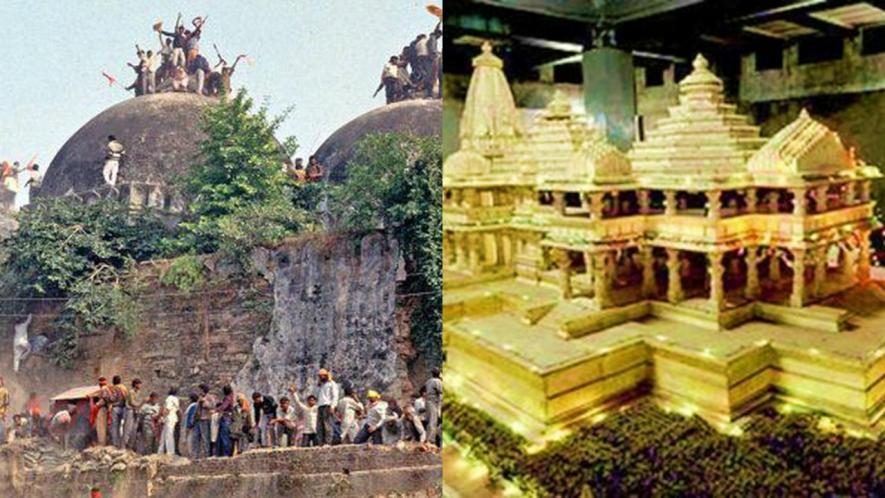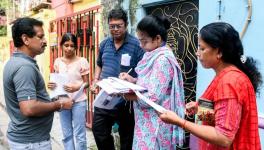Babri Masjid-Ram Janmabhoomi: Can this Nation Turn Back the Clock?

Since the 1980s, after the Ram Janmabhoomi Movement began attracting attention and I began tracking the 'story', in all dystopian imaginations of the future, the Bhoomi Pujan was not one of them. I presumed that after the shilanyas ceremony, performed on November 9, 1989, the formal groundbreaking ritual was over and done with. After all, that evening the Vishwa Hindu Parishad leader and original driver of the movement, Ashok Singhal, boasted that they laid the foundation of "not just a Ram temple, but of Hindu Rashtra".
But, I guess every generation of leaders wishes to have their golden moments engraved for posterity. It is all a matter of 'that' photo frame. The Ram temple is being 'delivered' by this regime; which chiefly consists of people who played little role in the actual agitation. This then, is a special event personally choreographed by Uttar Pradesh Chief Minister, Yogi Adityanath, to etch his moment and of course Prime Minister Narendra Modi's, at the head of the caravan of time. Unlike most members of the government-established trust, neither had much involvement in the Ayodhya agitation – the Yogi's spiritual predecessor to the Gorakhnath Mutt, Mahant Avaidyanath had been a leading light of the Sri Ram Janmabhoomi Mukti Yagna Samiti and member of Lok Sabha before he vacated the Gorakhpur seat for his protégé. Modi, besides being its biggest politically beneficiary so far, did not have any Ayodhya 'event' on his CV.
But, if someone has gained, who is the loser? Ironically, it will be the man who was chosen, back in 1989, to demonstrate existence of social inclusion within the sangh parivar – to prove even the 'lowest' caste was part of the biggest religio-cultural movement till then. His name – Kameshwar Chaupal, a member of the Scheduled Castes. Once again, it is the 'outcaste' who will be cast away from publicity and glamour! In his place, the pride of the place during Bhoomi Pujan shall be occupied by a man whose caste was included in the OBC list only in the 1990s, while his party's junior colleague was born into a Rajput family and grew up in one of the richest and politically influential Hindu monasteries of India. This underscores the exclusive nature of this elite Trust – just one member from the SCs, no tribals and certainly no women. Not just the temple trust, the ethos of the primary characteristic of the sangh parivar continues to be essentially savarna – note the predominance of upper caste men among its senior functionaries.
The one woman who had legitimate right to be present at the ceremony, Uma Bharati, chose to stay away, although after confirming her intention to remain present in the temple-town during the event with plans to visit the site subsequently. Her assertion that BJP, or the city of Ayodhya, has no monopoly rights over Lord Ram – a universal being mirroring myriad interpretations of the epic Ramayan and its central character – repudiates the BJP claim of the legendary hero being an epitome of Indian nationhood. After all, did not Goswami Tulsidas, writer of the most popular version of the Ram story say: ‘Avadh tahan jahan Ram nivasu’ (Wherever Ram dwells there is Avadh or Ayodhya)?
India certainly shall not change overnight. It is not that a certain India will wake up on August 5 and by the next morning get metamorphosed into a monstrous supremacist political organism. This dramatic transmogrification will not happen over a 24-hour period because the process has been underway for long. The list of those responsible for this is long and varied, although the sangh parivar essayed the most destructive role.
At times, it is tough to believe that it has been 28 years since the Babri Masjid was demolished. Readers may even think that I am churning out a yarn from the WhatsApp university of yore, by saying that visiting journalists almost invariably spent hot afternoons recouping after a long walk, inside the shade of the mosque and chatting with the communist turned priest, Lal Das, a few years earlier.
Yet, it is important to recall these nuggets of history purely to reiterate that this was a contested property, that the Supreme Court concurred with most arguments and agreed that the structure which was demolished was indeed a mosque and that it was actually desecrated on December 23, 1949, when the idol was surreptitiously installed in a dead of the night after a plan was drawn by the Hindu Mahasabha in connivance with the local magistrate. Yet, in their questionable wisdom, the five judges – one is now a nominated member of Rajya Sabha, unanimously awarded the entire land to Hindu parties.
Besides exercising the legal right to challenge even a Supreme Court verdict, the judgement has been accepted by Muslims and ideological adversaries of this regime, because they have greater commitment to the rule of law than the custodians of the State. Yet, disagreement with the court order has been, and continues to be voiced, because questioning a court for its ruling is no crime.
Will there be any closure of the Ayodhya chapter in Indian politics? Furthermore, how will India change and in which direction? Can, as an interviewer queried, the clock be set back now, that the pathway to an ostentatious temple will be formally paved by Modi?
Closure is a myth. The pain and disbelief shall never go. The wounded or those who were felled shall merely await the beginning of another day, try dusting away the hurt of the previous day and live for that day, committing to making peace with the new existence.
No nation can set the clock back, certainly not in a country with a much-disputed discourse. This is all the more so because the supremacist or majoritarian narrative shall not cease evolving and venture into new domains and fields. Driven by false reconstructed memory of the past, at odds with actual history, the sentiment of 'now it is our turn' has been legitimised. There is no 'action plan' for the future at the moment. But its nature is not hidden to anyone.
P.S. Hint: A day before the second foundation laying ceremony, a video surfaced on a social media group. A priest was carrying a large picture frame of Ram and Sita wrapped in gift paper. A young volunteer tore the wrapping paper mercilessly while using expletives. Why? The wrapped was GREEN in colour. Jai Shri Ram!
The writer is a Delhi-based writer and journalist. ‘The Demolition: India At The Crossroads’ was his first book published in 1994. He is currently working on a new book on the issue. He tweets @NilanjanUdwin
Get the latest reports & analysis with people's perspective on Protests, movements & deep analytical videos, discussions of the current affairs in your Telegram app. Subscribe to NewsClick's Telegram channel & get Real-Time updates on stories, as they get published on our website.
























